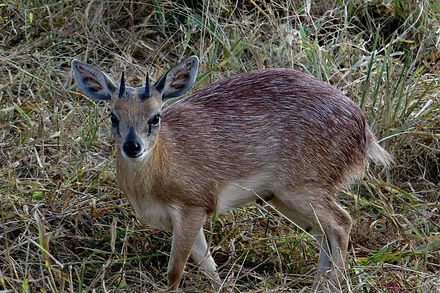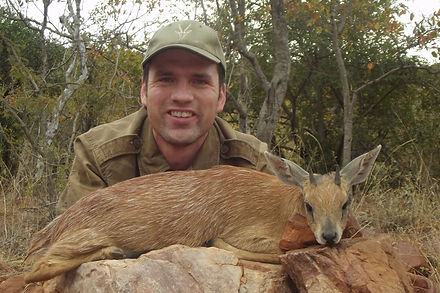Sharpe's Grysbok
Raphicerus sharpei
General Description
Scientific Name: Raphicerus sharpei
Subspecies: No Subspecies
Other common names: Northern Grysbok
Status: Least Concern (stable)
Population Estimate: 95,000
Population in Assessed Areas: Unassessed
Diet: Herbivore - mostly Browse, but also Grasses & Fruits, Nuts and Seeds
Male & Female Size: 7-11 Kgs
Trophy Size: Unknown
Generation Length: 4 years
Reproductive Season: Year Round
Time of Activity: Diurnal
Description: Most Sharpe's Grysbok weigh between 7-11 kgs and stand around 45-60 cm tall, with both sexes being roughly the same size. Only males have horns, which are usually only 7-9 cm long, though sometimes longer on older males.
Its coat is reddish-brown streaked with white; eye-rings, muzzle, throat and underside are off-white. The males have stubby horns, which are widely spaced. Sharpe's grysbok has a short, deep muzzle with large mouth and heavy molars for grinding. The short neck and head on a long-legged body result in a high-rumped posture when browsing. Sometimes it is confused with the larger Common Duiker where their ranges overlap, though the Grysbok smaller body size usually dispels this confusion.
Ecology: Their habitat is rocky hill country, but preferring fertile zones on the lower slopes. They are nocturnal browsers and spend the day in the protective cover of tall grass or shrubs. Across much of their range (Zimbabwe, Zambia and Tanzania), Sharpe's Grysbok appear to be associated with Miombo (Brachystegia) woodland where there is good undercover in the form of low-growing scrub or medium-length grass (Hoffmann and Wilson 2013). Although they appear to be associated with areas of good ground cover, Wilson (1975) recorded that they were also found in pure stands of Mopane (Colophospermum mopane) with very little good cover in Hwange National Park, while in Chobe National Park they were seen on a sandy plateau in open woodland with light grass and scrub cover.
Sharpe's grysbok browse on leaves, buds, herb and fruits—in the dry season, their food is typically tough (for which their teeth and jaws are adapted). Grazed grass makes up about 30% of their diet. They are also predated upon by a range of predators large and small, including leopards, wild dogs, caracals, cheetahs, and pythons, with lions and hyenas killing them less often.
Behavior: Sharpe's Grysbok are generally nocturnal, being active late in the afternoon. They are extremely timid and will run away at the first sign of anything unusual, although this flight is accompanied "short stamping hops". they move well away from where the disturbance occurred before stopping. Sharpe's Grysbok are reported to take refuge in aardvark burrows, like Steenbok. Each animal has a well-defined home territory. Like the Cape grysbok they use a communal latrine and mark sticks in its vicinity with pre-orbital gland secretions.
Reproduction: Relatively little is know about the breeding behaviors of Sharpe's Grsybok, mostly due to it's reclusive nature. But it's thought that it breeds all year round. Each female will produce 1-2 calves each year, and will raise them for around 6 months. Beyond that, nothing is known about their breeding ecology.
Conservation Analysis
Current & Historic range: Sharpe's Grysbok range from the western and southern parts of Tanzania, southwards through south-eastern DR Congo, Zambia (east of the Zambezi River), Malawi, Mozambique (not including the coastal forested regions), to extreme north-eastern Botswana and the eastern Caprivi Strip in Namibia, much of Zimbabwe, and north-east South Africa (Limpopo Province, eastern Mpumalanga) and eastern Swaziland (Hoffmann and Wilson 2013). It's range close to human settlements is becoming more fragmented, as habitat degradation and poaching reduces populations in some areas.
Current & Historic Populations: Historic populations of Sharpe's Grysbok were likely larger than they are today, due to the fact that todays populations face threats of habitat degradation. in 1999 populations were estimated to be 95,000 animals across their entire range, but this is likely to be a underestimate. Their reclusive nature and nocturnal habits makes surveying populations very hard, with many areas of potential habitat being overlooked in previous surveys. Hence it's recommended that populations should be studied more intensely, to accurately estimate total populations. They are still abundant in many areas, especially in protected reserves, national parks, or land areas where trophy hunting is used as a revenue source.
Threats to Species Survival: Sharpe's Grysbok is in no immediate danger of extinction, due to it's extensive range, large population, and the considerable portion of the population in protected areas. Habitat degradation and poaching has reduced some local populations considerably, especially in areas close to human settlements, but these have not had a significant impact on overall populations, especially when they are being hunted for the bushmeat trade. That being said, it can withstand considerable hunting pressure, even when dogs are used,
Recommended Conservation Actions:
-
Increased protection from development and poaching in populations close to human settlements.
-
Increase surveying capabilities of most of it's populations, especially outside of protected areas, where much about the status of this species is unknown.
*Further data on Sharpe's Grysbok populations and harvest numbers outside of South Africa and Namibia are largely incomplete, and hence it has not been evaluated by us. It is our goal to expand into other African Nations soon, so please do be patient with us.

Country | Population Estimate | Population Status | Last Assessed |
|---|---|---|---|
Zimbabwe | |||
Zambia | |||
Uganda | |||
Tanzania | |||
South Sudan | |||
Rwanda | |||
Nigeria | |||
Mozambique | |||
Malawi | |||
Kenya | |||
Gabon | |||
Equatorial Guinea | |||
Democratic Republic of Congo | |||
Central African Republic | |||
Cameroon | |||
Angola | |||
South Africa |
Economic & Cultural Analysis
Ecotourism Value: Low
Hunting Value: Moderate
Meat Value: Moderate
Average Trophy Value: $800-1,500 USD
Meat Yield per Animal: 3-5 kg
Economic Value/Impacts: Sharpe's Grysbok have significant economic value for an animal of their size, but it is less valuable than other more larger herbivores they share habitat with. Locals will hunt this species on occasion for meat, with small antelope populations like Grysbok being a significant factor in food security in rural areas. Cape Grysbok also have significant value to international trophy hunters. It's a key member of the "Tiny 10" slam, and one of the most difficult to hunt. Their nocturnal nature means many have to be harvested during the night, something very difficult to do.
Their value to ecotourism areas is significantly less, as their small size and reclusive nature means they often aren't noticed, and if they are, they're often overshadowed by more charismatic megafauna. They can also be impacted by elephant overpopulation in tourism areas within their South African range, so this can conflict with ecotourism interest.
Cultural Value: Sharpe Grysbok have likely been hunted by humans and our earlier Homo ancestors for millions of years, due to their small size, lack of defenses, and palatability. Their meat is said to be similar in taste to other antelope species, being very low in fat compared to domestic meats.
Region | Males Harvested | Females Harvested | Harvest Change | % of Population | Total Springbok Harvested 2024 |
|---|---|---|---|---|---|
Namibia (Incomplete) | |||||
Limpopo | |||||
Mpamalanga | |||||
KwaZulu Natal | |||||
North-West | |||||
Free State | |||||
Eastern Cape | |||||
Northern Cape | |||||
Western Cape | |||||
All of South Africa |
*Much of the data on Sharpe's Grysbok harvest numbers across their range is largely incomplete, and hence it has not been evaluated by us. It is our goal to expand our data set as much as possible, so every data contribution is highly valuable to us.
![Faunus_1.0-_(no_background)[1].png](https://static.wixstatic.com/media/684ede_9119f109be044e24997ff22fdfd55e34~mv2.png/v1/crop/x_31,y_0,w_365,h_402/fill/w_87,h_96,al_c,q_85,usm_0.66_1.00_0.01,enc_avif,quality_auto/Faunus_1_0-_(no_background)%5B1%5D.png)

.jpeg)


_JPG.jpg)
